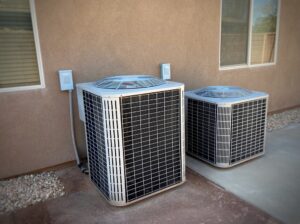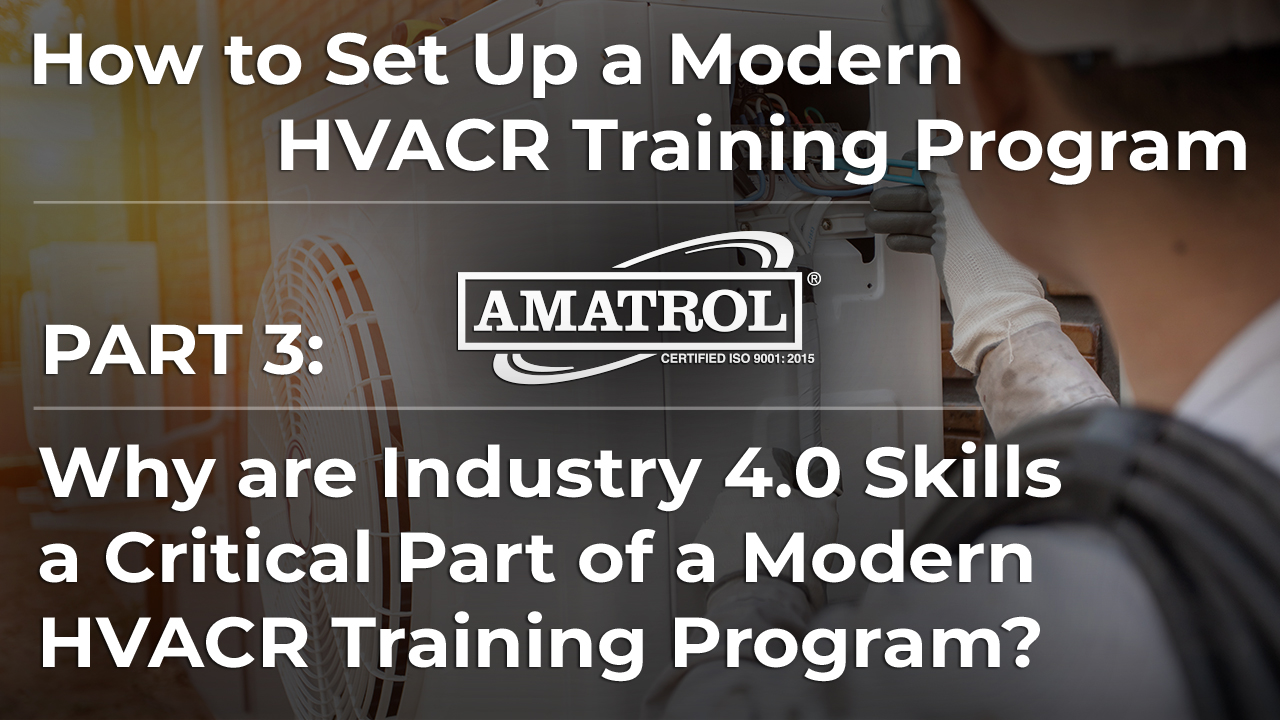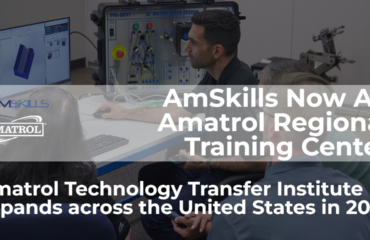*This article is part 3 of 5
In this series, we’ve already considered why it’s so important to teach HVACR skills. Simply put, highly-skilled HVACR technicians are in high demand today and the industry continues to grow rapidly. The world needs more HVACR technicians.
In the last article, we also took a deep dive into exactly what skills students and workers need, including the skills that form the foundation of any HVACR program, as well as the key basic and advanced skills specific to HVACR that future technicians will need to master.
We’re not quite done focusing on skills, though. There’s one emerging area we haven’t yet given its due: Industry 4.0. Are the smart automation technologies revolutionizing the rest of industry relevant to HVACR, too?
In this article, we will focus on why Industry 4.0 skills are a critical part of a modern HVACR training program. We’ll explain exactly what Industry 4.0 is, as well as highlight how advanced automation technologies are being used in modern HVACR systems and what advanced Industry 4.0 skills the HVACR technicians of today and tomorrow need to succeed.
What is Industry 4.0?
If you’ve spent any time around the world of manufacturing over the past several years, then you’ve probably heard the term “Industry 4.0” from time to time. But what does it mean exactly? In a nutshell, Industry 4.0 refers to the Fourth Industrial Revolution, which also goes by a variety of other phrases, such as the Industrial Internet of Things (IIoT), Smart Factory, Smart Automation, Smart Manufacturing, etc.
The Fourth Industrial Revolution describes the technological revolution taking place today in factories around the world. During the original (First) Industrial Revolution, steam mechanized production. Then electricity enabled mass production during the Second Industrial Revolution. Eventually, the Third Industrial Revolution saw computers spur automated production.
Some people believed computers were the final frontier. Could anything truly revolutionize industry once again? The Internet said, “Watch this!” We now live in a “smart” world in which countless devices communicate with other devices via the Internet to make life more convenient in seemingly-endless ways. This infinite web of connected devices even has a name: the Internet of Things.
Industries around the world are combining the Internet of Things with cyber-physical systems and advanced automation technologies to create new smart factory environments. Together, these new technologies hold huge potential for a major leap in productivity and efficiency.
Examples of the new technologies spurring the Fourth Industrial Revolution include: “smart” or connected product identification (barcode, RFID, and vision) and sensors (ultrasonic, photoeye, vacuum, etc.); Ethernet and wireless networking and network security; data analysis and production monitoring software; and manufacturing execution software that automates maintenance tasks via smartphone apps.
The synergies created by these exciting new Industry 4.0 technologies promise huge gains in industrial efficiency and productivity. That’s why HVACR companies around the world have started incorporating them into a wide variety of products.
As author Don Gillis notes in an Emerson Climate Conversations blog article, “[m]odern refrigeration and air conditioning applications utilize advanced controls, software and remote diagnostics capabilities.” Today’s HVACR technicians need advanced skills to keep up with these new cutting-edge technologies.

How Common are Smart HVACR Systems Today?
Some may think that smart HVACR technologies are nothing more than a future possibility, but the truth is that they’re already here and more prevalent than you probably realize. In fact, a visit to your local electronics superstore or home supply warehouse will reveal a wide selection of devices that’ll turn your humble abode into a smart home.
Indeed, if you’re an early adopter of new technologies, your home may already feature one of these devices, such as a smart thermostat. Unexpected cold front move in during the afternoon while you were at work? No worries! Just open your smartphone app and kick the temperature up a couple notches, so it’s nice and toasty when you get home.
To get a better idea of how smart technologies are already being included in modern HVACR systems, consider HVACR giant Carrier. As author Mary K. Pratt notes in a recent CSO article, Carrier is “one of the most recognizable brands in the HVAC space” with “more than 80 brand businesses manufacturing thousands of components, products, and complex systems. Its products include industrial control systems, building management systems, automation systems, smoke detectors and commercial refrigeration…operational technology, firmware, and software.”
Pratt points out that “[l]ike other manufacturers, Carrier has been adding digital technologies to its mechanical products, connecting them to the internet and making them ‘smart’ in the process.” “For example, one of the Carrier business lines makes transport refrigeration equipment and cold chain tracking and monitoring solutions to keep items, including vaccines, cold as they make their way around the globe. The company also makes smart smoke and carbon monoxide detectors with indoor air quality monitors.”
With more and more HVACR products incorporating advanced Industry 4.0 technologies, the need for highly-skilled technicians who can operate, maintain, repair, and troubleshoot these systems is greater than ever. Are your students prepared for HVACR 4.0?
What Types of Advanced Industry 4.0 Skills do HVACR Technicians Need Today and into the Future?
Making HVACR products “smart” ups the ante when it comes to the advanced skills today’s technicians will need. In addition to a wide variety of electrical, mechanical, and HVACR-specific skills, the HVACR technicians of today and tomorrow must expand their skillsets to include expertise with connected systems, Ethernet and wireless communications, smart sensors, etc.
Here’s a quick look at just a few of the advanced Industry 4.0 skills that will be important to teach the next generation of HVACR technicians:
Smart Thermostats
As mentioned previously, smart thermostats are changing the way homeowners monitor and control their residential HVACR systems, and it’s easy to see why. With heating and cooling costs continuing to rise year after year, the ease and convenience of keeping an eye on the thermostat via a smartphone app is a no-brainer for those wanting to reign in their utility bills.
HVACR technicians need to learn how to install, operate, maintain, and troubleshoot smart thermostats. Necessary skills will include how to install and operate related smartphone apps, as well as teaching homeowners how to use key features.
Smart Sensors & Probes
As HVACR systems get “smarter,” traditional ways of measuring and monitoring critical factors, such as temperature and pressure will be replaced with a variety of smart sensors and probes that can communicate not only system issues but also routine maintenance reminders and requests.
HVACR technicians will need to know how to install and troubleshoot a range of smart sensors and probes, especially those used commonly with the latest generation of digital gauge manifolds. They will also need to become familiar with configuring the devices that will receive critical communications from connected probes and sensors.
Smart Refrigeration & Chiller Controllers
Today’s advanced smart refrigeration systems, as well as air- and water-cooled chiller systems, feature advanced controllers that enable users to optimize energy use throughout the entire system. This is especially important in the commercial setting. With a smart controller, users can monitor and manipulate key components of the system, such as evaporator and condenser fans, compressors, and even lights.
HVACR technicians working with advanced refrigeration and chiller systems will need to know how to install, operate, and troubleshoot smart controllers. Key skills will include configuring a controller for single- and multi-zone operation, configuring a controller for use with an electronic expansion valve, configuring a smart chiller controller using Bluetooth and/or a mobile/cloud app, and monitoring controller function via software.
Smart Communications
Last, but certainly not least, HVACR technicians must become fluent in the installation, configuration, operation, and troubleshooting of the advanced technologies used to connect HVACR components together and to the Internet. After all, advanced smart communications technologies lie at the very heart of Industry 4.0.
For example, HVACR technicians must learn how to set up Ethernet and WiFi networks, including configuring and testing Ethernet network addressing for connected HVACR devices. Once smart devices, components, sensors, and probes are connected, monitoring and communication must be configured via a variety of technologies and user interfaces, including software, mobile/cloud apps, and Bluetooth communications.
Modern HVACR Training: Evolving to Meet Future Demands 
In this article, we’ve highlighted Industry 4.0 skills and how advanced automation technologies are being used in modern HVACR systems. We’ve also provided guidance on what advanced Industry 4.0 skills the HVACR technicians of today and tomorrow need to succeed.
In the next article in this series, we’ll take a closer look at how HVACR skills have been taught in the past. We’ll also examine why new training systems are vital to modern HVACR training, including teaching critical Industry 4.0 skills.
About Duane Bolin
Duane Bolin is a former curriculum developer and education specialist. He is currently a Marketing Content Developer in the technical training solutions market.




